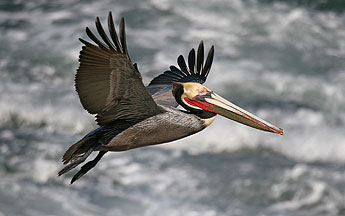
Since the 1970s, numbers of California brown pelicans have increased dramatically along the West Coast of the United States. UCSC researchers reported pelicans are now nesting on Prince Island for the first time since 1939. Photo:
Joyce Gross |
June 12, 2006
More signs of return for California brown pelicans
For the first time since 1939, endangered California brown pelicans are nesting on Prince Island, according to UCSC seabird biologists and the California Department of Fish and Game.
As part of a contract with the Department of Fish and Game Office of Spill Prevention and Response, UCSC biologists Breck Tyler and Phil Capitolo counted 43 pelican nests on May 16 during an aerial monitoring survey of seabird breeding colonies in the Channel Islands National Park and the Channel Islands National Marine Sanctuary.
Prince Island, located near San Miguel Island at the north end of the pelican's main historical breeding range in southern California, is one of three current breeding locations in California; pelicans nested there sporadically at least until 1939. Natural colony re-establishment at Prince Island and other historic breeding sites could reflect the continuing return of this endangered seabird.
The California brown pelican is a subspecies of the widely distributed brown pelican. It breeds in the Gulf of California, along the Sinaloa and Nayarit coast of mainland Mexico, along the Pacific coast of Baja California, and north to the California Channel Islands. Nonbreeding pelicans range north along the Pacific coast as far as Washington and British Columbia.
Following reproductive failure, severe population decline, and colony losses from the 1940s to 1970s, the California brown pelican was listed as endangered by the U.S. Fish and Wildlife Service in 1970 and by the California Fish and Game Commission in 1971. The pelican is also identified as a Fully Protected species in California under Section 3511 of the Fish and Game Code.
The Fish and Wildlife Service was petitioned to delist this subspecies in California in December 2005, and recently completed an initial 90-day review of that petition. The Fish and Wildlife Service will now undertake a more comprehensive study, known as a 12-month status review, to determine whether to propose the California brown pelican for delisting. The Fish and Wildlife Service will also review the status of all brown pelicans currently protected under the Endangered Species Act throughout their range as required.
The decline of the California brown pelican caused by persistent marine pollutants was one of the major events that helped to develop public concern for the environment and led to environmental protection laws in California in the late 1960s and early 1970s.
Contamination by the pesticide DDT resulted in thin eggshells that broke under the pressure of incubating adult pelicans. The pesticide was determined to be the primary cause of reproductive failures and population declines in southern California and coastal Baja California and was banned in the United States in 1972.
Human disturbance of breeding colonies and roosts also contributed to population declines and poor reproduction. Oil spills and entanglement in fishing tackle are other known threats to this species.
After being reduced to small numbers from the 1960s to 1980s, the brown pelican is again becoming a common bird along the U.S. West Coast as a result of recovery efforts in the last three decades.
Researchers from UC Davis and the California Institute of Environmental Studies began studying the remaining U.S. colony of birds at Anacapa Island in 1970. The size of this colony fluctuates annually, as is typical of the species, but has increased since the early 1980s to a mean size of about 4,000 to 5,000 pairs. In 1980, a second U.S. colony was established at Santa Barbara Island and has been monitored by the California Institute of Environmental Studies and Channel Islands National Park. Since then, this colony has grown to several hundred pairs.
During the last year, California Institute of Environmental Studies biologists found other indications of the seabird's continuing recovery, including the first-known nesting at Middle Anacapa Island, small numbers breeding on East Anacapa Island (only the second time since 1928), and an expanded distribution of pelican nesting at Santa Barbara Island. Since the 1970s, numbers of nonbreeding California brown pelicans have also increased dramatically in northern California, Oregon, and Washington.
UCSC aerial photographic surveys of seabird colonies in southern California are being supported by the Department of Fish and Game Office of Spill Prevention and Response. Seabirds are vulnerable to impacts from oil spills and chronic oil pollution, as well as disturbance caused by human activities occurring too close to breeding areas.
Using aerial photographs, seabird biologists are able to count birds and nests to estimate population sizes and trends for assessing continuing injuries to natural resources from oil spills and other marine pollutants. Aerial photographs are also used to study the success rates of restoration projects designed to assist natural recovery. The Department of Fish and Game Office of Spill Prevention and Response provides partial funding for similar surveys in central and northern California.